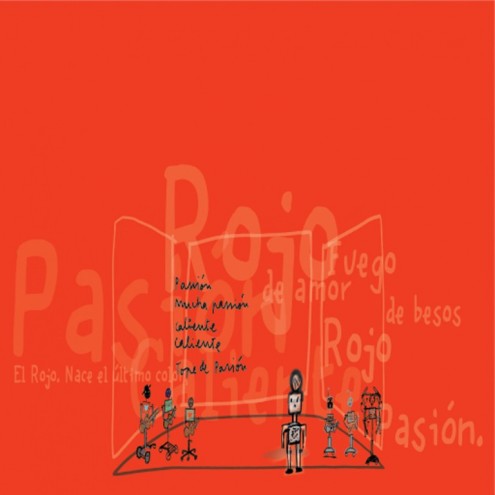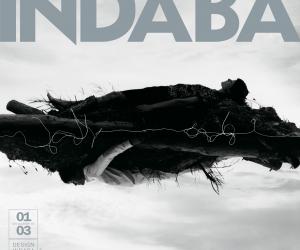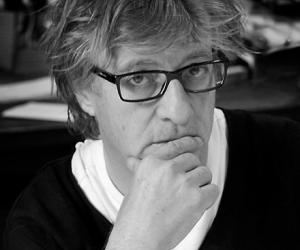First Published in
You cannot escape Javier Mariscal's children. He talks about them all the time.
"Alma, she is a private, loving little girl, always wanting to be close. So sweet. She represents the soul in people," he says of one of his fifteen-month-old twins. Her brother Linus, by contrast, comes across as a challenging tearaway. A real boy. "His first words were 'brmm, brmm', says Mariscal, probably because of the experience he's had on 50 or so Vespa and Lambretta scooters his father owns.
The twins are clearly an inspiration to Mariscal and his observations of their character traits and antics pepper every conversation. And Alma and Linus are not the first to share the fantasy world he has instinctively created around him. His older daughter Julia, now studying in London, has accompanied him on many trips abroad, not least to the UK when he was creative head of the graphics team behind Scottish city Glasgow's reign as 1999 City of Architecture and Design and she was to be seen as a poised teenager at many an official gathering.
'Kids give you a lot of things,' says Mariscal. But, as his work shows, his fascination with them is more than just the usual obsession of a proud parent. It's a case of like meets like, in that he is as childlike as they are in his appreciation of life, displaying the wonderfully naive qualities of both toddlers. A charming trait in a highly creative 52-year-old man.
Nor does Mariscal's joy in youth and life stop with his own offspring. He talks with considerable pride about the kids, spouses and dogs of his 40-plus team, a constant stream of humanity that happily invades his office, an old factory in Barcelona. He is a family man and that family seemingly has no bounds. His life is about sharing, enjoying and having fun, be it work, duty or sheer fun.
It is this open approach that has enabled Mariscal to develop as he has, with an enviable freshness and infectious joie de vivre. To some a cartoonist, to others a designer in the broadest sense, it is hard to pin him down.
He has come a long way since the days of General Franco's fascist regime in Spain, when as a North African immigrant in his early career as an alternative strip cartoonist he attracted the attention of government censors. With the fall of that regime and the end of a period of self-imposed exile in Ibiza, his exhuberant style came to embody the spirit of Spain's rebirth as a creative nation, with his adopted Barcelona at its cultural heart.
His entry on to the international stage came ironically with an intensely nationalistic project, the creation of Cobi as the mascot for Barcelona's 1992 Olympic Games. The dog-like Cobi, described at the time by some as 'the squashed victim of a road accident' though now revered as a design classic, draws on Mariscal's cartoonist past. But Cobi's manifestation in three dimensions says more about the way his career has panned out. He works across all media from graphics and animation to music and structure in a multitude of situations, collaborating with the likes of Spanish architect Alfredo Arribas on the one hand and former Anglo-German graphics group MetaDesign on the other.
His repertoire covers fashionable restaurants and bars, including work on Bilbao's presitigious new Gran Hotel Domine, where his love of colour and fun dominates the Crash bar, for example textiles, furniture and typography, including the branding for Glasgow's Lighthouse design exhibition venue, working alongside MetaDesign.
Mariscal is highly successful as a designer, but talking to him it becomes clear that his career has never followed a plan. It just evolves. His cartoons started with sketches of naked girls he drew for his friends on the school bus, aged 14, and moved on from there. Now he likes gardens, 'so we started to do a lot of trees - fake trees', which manifest as quirky sculptures around the office and in projects like the Bilbao hotel.
Words and humour come into everything he does, as does music. He is truly eclectic.
He is also a fantastic storyteller, as those who saw his riotous showstopping Story of Colors at Cape Town's Sixth Design Indaba will attest. Wildly imaginitive, but with all the Charlie Chaplinesque pathos of the silent movie, the animated tale of three characters experiencing the development of the spectrum - and its social and political implications is layered with puppetry, music and energetic live commentary by Mariscal himself. It's a hedonistic carnival and an inspiration. Its style speaks volumes about its creator.
So what does Mariscal make of the wonderfully crazy world he's created for himself and his collaborators? 'It's good working in design,' he says. 'They pay you for fun and pay me for learning.' As for the man himself, to sum him up in his favourite words, he's so sweet, so nice.
You cannot escape Javier Mariscal's children. He talks about them all the time.
"Alma, she is a private, loving little girl, always wanting to be close. So sweet. She represents the soul in people," he says of one of his fifteen-month-old twins. Her brother Linus, by contrast, comes across as a challenging tearaway. A real boy. "His first words were 'brmm, brmm', says Mariscal, probably because of the experience he's had on 50 or so Vespa and Lambretta scooters his father owns.
The twins are clearly an inspiration to Mariscal and his observations of their character traits and antics pepper every conversation. And Alma and Linus are not the first to share the fantasy world he has instinctively created around him. His older daughter Julia, now studying in London, has accompanied him on many trips abroad, not least to the UK when he was creative head of the graphics team behind Scottish city Glasgow's reign as 1999 City of Architecture and Design and she was to be seen as a poised teenager at many an official gathering.
'Kids give you a lot of things,' says Mariscal. But, as his work shows, his fascination with them is more than just the usual obsession of a proud parent. It's a case of like meets like, in that he is as childlike as they are in his appreciation of life, displaying the wonderfully naive qualities of both toddlers. A charming trait in a highly creative 52-year-old man.
Nor does Mariscal's joy in youth and life stop with his own offspring. He talks with considerable pride about the kids, spouses and dogs of his 40-plus team, a constant stream of humanity that happily invades his office, an old factory in Barcelona. He is a family man and that family seemingly has no bounds. His life is about sharing, enjoying and having fun, be it work, duty or sheer fun.
It is this open approach that has enabled Mariscal to develop as he has, with an enviable freshness and infectious joie de vivre. To some a cartoonist, to others a designer in the broadest sense, it is hard to pin him down.
He has come a long way since the days of General Franco's fascist regime in Spain, when as a North African immigrant in his early career as an alternative strip cartoonist he attracted the attention of government censors. With the fall of that regime and the end of a period of self-imposed exile in Ibiza, his exhuberant style came to embody the spirit of Spain's rebirth as a creative nation, with his adopted Barcelona at its cultural heart.
His entry on to the international stage came ironically with an intensely nationalistic project, the creation of Cobi as the mascot for Barcelona's 1992 Olympic Games. The dog-like Cobi, described at the time by some as 'the squashed victim of a road accident' though now revered as a design classic, draws on Mariscal's cartoonist past. But Cobi's manifestation in three dimensions says more about the way his career has panned out. He works across all media from graphics and animation to music and structure in a multitude of situations, collaborating with the likes of Spanish architect Alfredo Arribas on the one hand and former Anglo-German graphics group MetaDesign on the other.
His repertoire covers fashionable restaurants and bars, including work on Bilbao's presitigious new Gran Hotel Domine, where his love of colour and fun dominates the Crash bar, for example textiles, furniture and typography, including the branding for Glasgow's Lighthouse design exhibition venue, working alongside MetaDesign.
Mariscal is highly successful as a designer, but talking to him it becomes clear that his career has never followed a plan. It just evolves. His cartoons started with sketches of naked girls he drew for his friends on the school bus, aged 14, and moved on from there. Now he likes gardens, 'so we started to do a lot of trees - fake trees', which manifest as quirky sculptures around the office and in projects like the Bilbao hotel.
Words and humour come into everything he does, as does music. He is truly eclectic.
He is also a fantastic storyteller, as those who saw his riotous showstopping Story of Colors at Cape Town's Sixth Design Indaba will attest. Wildly imaginitive, but with all the Charlie Chaplinesque pathos of the silent movie, the animated tale of three characters experiencing the development of the spectrum - and its social and political implications is layered with puppetry, music and energetic live commentary by Mariscal himself. It's a hedonistic carnival and an inspiration. Its style speaks volumes about its creator.
So what does Mariscal make of the wonderfully crazy world he's created for himself and his collaborators? 'It's good working in design,' he says. 'They pay you for fun and pay me for learning.' As for the man himself, to sum him up in his favourite words, he's so sweet, so nice.
















